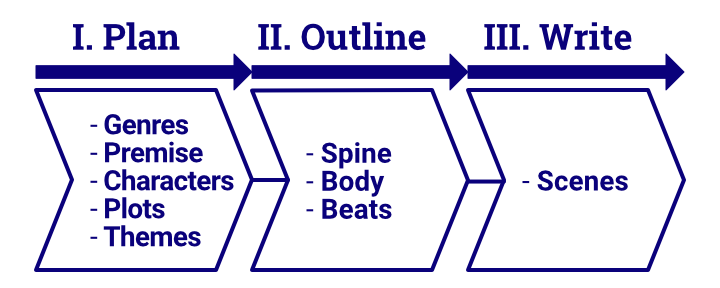By: Grant P. Ferguson
Last Updated: February 7, 2024
It takes a significant effort to turn an idea into a premise—the story’s big picture and writer’s development strategy. Now you face figuring out the plot (i.e., what happens within the story). If you’re stuck trying to turn a premise of a story into a plot, do this instead: build a story spine.
Plot Advice
As I researched how to turn a premise into a plot, I saw many articles focusing on story structure. Only a few gave writers a proven method to bridge the gap between premise and plot.
For example, most suggested using one of a dozen different story-structure formulas, but that can seem overwhelming. Juggling too many details can keep you from creating a working plot.
Plot Using the Trellis Method
I prefer to take a three-phase approach, where each step in the writing system (e.g., premise development) leads to the next as your story unfolds.

Start Here: Build a Story Spine
In How to Write a Premise for a Book, I shared this working example:
When the murder of a client disrupts an introverted gallery owner’s peaceful life in the Texas Hill Country, she uses her art investigative skills to identify the killer and discovers the intriguing odyssey of a priceless painting looted in World War II.
And in Build a Story Spine, I gave the framework to create what happens in your story based on 8 of the 18 Story Beats. Below are the beats next to the Story Spine prompts:
- HOOK: Once upon a time there was ____.
- SETUP: Every day, ____.
- TRIGGER One day ____.
- THRUST INTO 2: Because of that, ____.
- MIDPOINT: Since that happened, ____.
- PLUNGE INTO 3: As a result of that, ____.
- CLIMAX: Until finally ____.
- RESOLUTION: And ever since that day____.
Main Plot and Subplots Story Spines
Writing Principle: As you envision the entire story, keep in mind the relationship between the main plot and subplots. It’s much easier to arrange all the pieces if you build a Story Spine and flesh out a Story Body for the main plot and each subplot. The Story, Spine, & Beats Development Workbook gives the instructions and worksheet to make this happen.
Keep It Super Simple
It’s easy to get lost in the details when you try to plot your story. That’s why I begin with the Story Spine. You’ve probably heard dozens of fairy tales, right? The simple format makes it easy to turn a premise into a plot.
The questions shown in How to Write a Premise for a Book create a whirlwind of ideas. The prompts in the free Character Profile (see: How to Create the Ultimate Character Arc) will generate more details you can use to complete the Story Spine.
For instance, I came up with several ideas and details while completing the Character Profile for the chief character, Dorothy:
- Opposition: In her Character Profile, Dorothy (i.e., the story’s amateur sleuth) faces key conflicts:
- The main character resists the call to sleuth because she fears the loss of her idyllic life. (See the Core Conflict below.)
- Her best friend’s troubled past feeds sleuth’s fears.
- Local police chief first encourages, then hinders sleuth.
- The beautiful small-town setting changes from idyllic to deadly.
- Sleuth faces off against five different suspects, and several threaten her, spouse, and dog.
- Core Conflict: This cozy mystery pits the sleuth against an elusive murderer. The main character resists the call to sleuth because she fears the loss of her idyllic life. In the SETUP, I envision the sleuth’s husband foreshadowing the story’s theme with his encouragement to Dorothy. “You can’t let fear hold you back from what you’re called to do.”
- Theme: While creating the Character Profile for the lead, I came up with the working themes.
- External: This will be a murder mystery, so the crime genre calls for an external theme of Justice versus Injustice. As an inexperienced amateur sleuth, Dorothy has to overcome her inner resistance and assert herself, which sets up the internal theme.
- Internal: If the killer is brought to justice, Dorothy can restore the perceived peace of her idyllic life that she enjoyed before the murder (i.e., the Lie), so the internal theme will be Accept Sleuth Call versus Ignore Sleuth Call.
- Philosophical: If Dorothy holds back (i.e., she ignores the call out of fear of asserting herself and losing her idyllic life), that’s a form of selfishness because she would be focused on her quest for internal peace instead of the selflessness of using her abilities to solve the murder. Thus, the philosophical theme will be Selflessness versus Selfishness.
More details will unfold as I progress. For example, the genre’s obligatory scenes and conventions, the small town settings and surrounding countryside, the stakes for the sleuth and community, the secrets tied to the villain and other characters, and the twists designed to surprise and delight readers.
The Trellis Method lays out everything and forms a unique writing system.
Put the Story Spine to Work
Here’s my bare-boned plot structure upon which I will build the story:
Once upon a time there was an art gallery owner who loved her idyllic life in a small town, but while walking her dog, she came across a body — her client! [HOOK]
Every day, she felt more compelled to find out who killed him. Using her sleuthing skills honed investigating art, she tried to identify the killer, causing friction at home, conflicts with friends, and hindrances from the police chief. [SETUP]
But one day, she discovered the intriguing odyssey of a valuable painting looted in World War II—the same painting her dead client had left for appraisal! [TRIGGER]
Because of that, she began interviewing five suspects who had unique reasons to do away with her client. [THRUST INTO 2]
Since that happened, she encountered more conflicts, forcing her to face the real possibility she might lose her idyllic life if she continued investigating the murder, but instead of letting fear hold her back, she vowed to follow her calling. [MIDPOINT]
As a result of that, she eliminated all but one suspect, but closing in on the killer put Dorothy and her husband in danger. When she confronted the suspect, he denied the allegation, and that set off a series of events that would shift Dorothy’s life from idyllic to deadly. [PLUNGE INTO 3]
Until finally, she and husband faced certain death at the hands of the killer. They tried to escape, and failed twice, but Dorothy’s fearless taunts allowed the police chief to arrive undetected and capture the distracted killer. [CLIMAX]
And ever since then, she and her husband grew closer, and he encouraged her to continue her calling as the small town’s resident amateur sleuth. [RESOLUTION]
Story Spine Purpose
As you turn a premise into a plot, consider this blog excerpt from the Story Spine’s originator, Kenn Adams:
…the Story Spine is not the story, it’s the spine. It’s nothing but the bare-boned structure upon which the story is built. And, that’s what makes it such a powerful tool. It allows you, as a writer, to look at your story at its structural core and to ensure that the basic building blocks are all in the right place.
Flesh Out the Story Body
In the next step, the Story Body helps you write the short version of the entire narrative.
After that phase, you’ll have the essential details to complete the Story Beats, a crucial step. Then we will tackle the Scenes and Scene Sequences.
Related Post
- Busy Writers: Validate Your Story Premise to Confirm a Winning Strategy
- 11 Tips on How to Create Your Story Premise BEFORE You Write
- How to Write a Premise for a Book
Resources
Leave a Reply
How do you turn a premise into a plot? Your challenges?


Leave a Reply